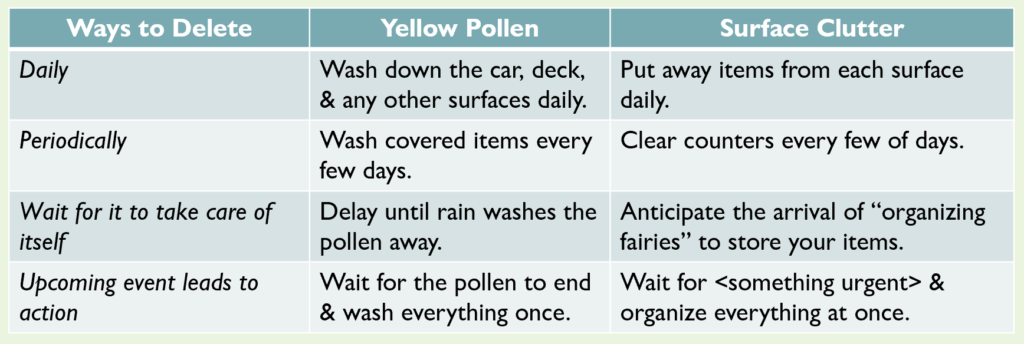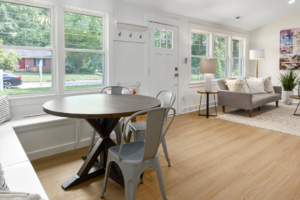
How do I keep my counters clear?
March in Raleigh, NC means we are either very close to Yellow Season or in the middle of it and waiting for it to end!
Never heard of Yellow Season? Every spring in my part of North Carolina, we have a few weeks when absolutely everything outside is covered in a coat of thick yellow pollen. Rocking chairs on a porch, cars, sidewalks, front doors, even your hair, if you stand outside for too long.
Fortunately, this only lasts for a few weeks before we go back to our “regular” amounts of pollen and dust.
Similarly, sometimes surfaces in our home or office get coated with clutter. The untidiness may not be thick yellow dust, but it is papers, books, electronic cords, mail, packaging, clothing, etc. Unfortunately, this surface clutter doesn’t usually just go away after a couple of weeks.
Here are some lessons from thick yellow pollen that we can apply to surface clutter:

Of the four choices for deleting surface clutter, three of them require action. Two of those three need intentional, consistent action. Not the answer you were hoping for, I’m sure.
The point is, there is a choice.
I confess that with pollen, I usually just wait for the rain.😊With items in my house or office, there are certain belongings I put away daily and others that I deal with weekly or even monthly. There are a few times when I wait for the impending arrival of guests before I organize an area (yes, even really organized people may have some clutter!) And while I keep waiting for the organizing fairies, they are always no shows!
In the best of times, it can be challenging to keep your surfaces clear. When you’re impacted by a medical diagnosis, it can be even more difficult. Here are some ideas that may be helpful:
SELECT SUCCESS TOOLS
- Snail mail: convenient recycle bin, shredder, processing tools (pens, highlighter, sticky notes, etc.)
- Other papers (notes, test results, appointment slips, etc.): notebooks, folders, and calendar, or other options depending on what makes sense for you.
- Purchases: method for getting items to their destination. This could include delegating to another member of the household. Or you might have bins for all objects going to certain parts of the house so they can be taken at the same time rather than in multiple trips.
KNOW YOUR FLOW
If you always bring items in your space and don’t delete (recycle, shred, consign, eliminate, etc.) anything, you’re adding to the clutter. Be intentional in removing stuff on a regular basis.
Remember, not making a decision to edit declutter as you go along, just postpones the activity for later and creates bigger piles.
MINIMIZE INSIDE CLUTTER
Inside clutter is the brain chatter that tries to talk you into or out of a decision or action. Examples include:
- why you should keep something you haven’t used in several months or years (ask questions like “When will I use it? Who will use it? What will it be used for? to challenge that inside voice)
- you don’t know what to do with it (by the way, delaying the action may or may not clarify what happens next)
- waiting for the “right” moment (how do you know when it’s the “right moment”?)
There are several approaches to counteract inside clutter. Here are two: Challenge them (“I will not listen to you!”) OR Talk Back (“I know this appointment is in my calendar, so I don’t need to keep this paper as a reminder.”)
You may have a medical situation that inherently limits your ability to complete daily tasks. Here are three examples along with some strategies to address these issues:
Energy-sapping diagnoses (depression, fibromyalgia, etc.).
Many disorders can make you more tired than usual. However, there are some that make you bone-weary and beyond exhausted.
One solution is to get help. You might have family or friends who could assist on a periodic basis. Another option is to hire someone. It might be a responsible teenager, personal concierge company, or an organizing professional.
Physically-hindering diseases (dystonia, osteoarthritis, sleep apnea, etc.).
“Physical disability is defined as a limitation on a person’s physical functioning, mobility, dexterity or stamina.” (United Spinal Association. “What is a Physical Disability.” Written February 28, 2024. Retrieved March 27, 2024.) These impediments can range from mild to severe in terms of pain and impact. While physical disabilities hinder a person’s capacity to do activities of daily living (ADLs), such as climbing stairs, doing laundry, grooming, etc., to one degree or another, it is possible for someone to have a good quality of life. If you want an example, just contact me and I’ll point you to some amazing people!
One key is to create a supportive physical environment. Depending on the condition, this might include having the primary bedroom on the first floor, maintaining CPAP equipment, or locating all regularly used items so they can be easily reached.
Time-consuming conditions (cancer, surgery, etc.).
While many afflictions will impact your time in some way, I’m specifically thinking of diagnoses that have ongoing treatment requirements. For instance, cancer treatment may involve radiation or chemotherapy and surgery may involve physical therapy (PT). Just ask me. I’m the queen of orthopedic issues that require PT!
One key is to drop, defer, or delegate some activities. While there may be commitments that you want to participate in, your healing is more important. As such, it’s crucial for you to concentrate on the most important tasks. This will include processing medical papers on your counter.
Even though I differentiated the medical issues into three categories (energy, physical, time), it’s very possible that your condition involves multiple areas.
What one very small action will you take today to decrease your surface clutter? It can be incredibly tiny!
Typing your “one very small action” in the comments below will make you more likely to take action!


